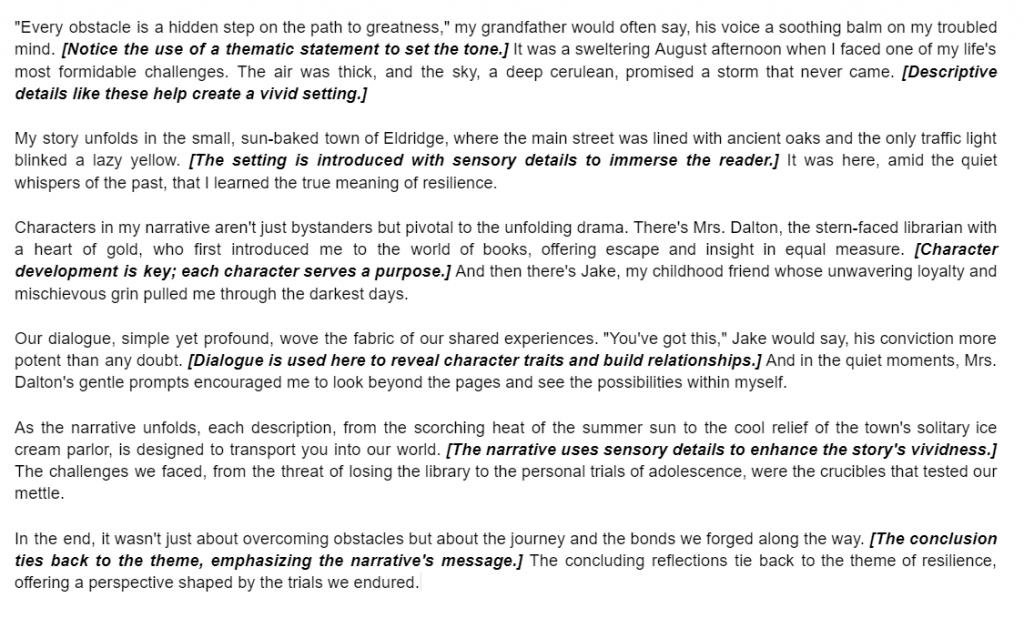Narrative essays are where storytelling and reflection come together, inviting writers to turn personal experiences into engaging stories that connect with broad, common themes. This approach not only improves the ability to express but also deepens the connection with readers by offering insights and shared human experiences. Specifically, a narrative essay uses personal stories to explore these themes, mixing real-life experiences with reflective insights.
As we delve into this essay type, we’ll explore creating a strong thesis, structuring our narratives, and incorporating key elements that bring stories to life. This journey in narrative essay writing goes beyond mastering a literary form; it’s about using the power of storytelling to inform, convince, and reflect. Whether you’re improving your skills or trying narrative writing for the first time, this article offers valuable insights to make your stories impactful and meaningful. Embark on your narrative essay journey with us below!
Developing a strong thesis statement for your narrative essay
A well-prepared thesis statement is crucial for setting the tone and direction of your narrative essay. It captures the main idea, blending personal experiences with broader themes or lessons. Here are key considerations and steps for preparing an effective thesis:
- Clarity. Your thesis should clearly articulate the central theme or lesson of your narrative. It must be concise yet powerful, guiding readers through your story’s journey.
- Personal connection. Make sure your thesis reflects a personal insight or transformation. A relatable thesis boosts engagement and deepens the impact of your narrative.
- Universality. While based on personal experience, your thesis should also touch upon universal truths or experiences, resonating with a wider audience.
- Foreshadowing. A subtle hint at the narrative’s key events or conflicts within your thesis can intrigue readers, sparking curiosity about how the story unfolds.
Now that we’ve outlined the key elements of a strong thesis, let’s move on to some practical tips for preparing your thesis statement:
- Identify the main message. Reflect on the most significant insight or lesson from your experience. How can this lesson be universally applied or understood?
- Early drafts. Begin with a preliminary thesis to shape your narrative. Don’t hesitate to revise it as your story and its themes become clearer.
- Seamless integration. Place your thesis at the end of your introduction. This strategic positioning ensures a smooth transition into the body of your essay, where you’ll elaborate on the narrative and its importance.
By focusing on these elements, you lay a solid structure for a narrative essay, ensuring your personal story conveys a meaningful and resonant message.

Structure of a narrative essay
Every narrative essay is built on a familiar structure that includes an introduction, body paragraphs, and a conclusion, guiding the reader through a journey from the opening scene to the final reflection.
Introduction
Your essay’s opening sets the stage, inviting readers into the story you’re about to unfold. It’s your chance to capture the audience’s attention with clear, descriptive details and engaging information. The introduction should not only present your story but also link it to your central thesis statement, creating the thematic direction of your narrative right from the start.
Body paragraphs
This section is the heart of your essay, where the story’s details come to life. Here, you’ll alternate between narrating events and reflecting on their significance. To keep up a smooth flow, use transitions thoughtfully, ensuring that your narrative’s pace and rhythm keep the reader fully engaged.
Conclusion
The conclusion is the foundation of your essay, bringing together all parts to support your main thesis and important points. It’s the part where you make a lasting impression, ensuring your narrative resonates well after the reading ends. Achieve this by:
- Reflect on the lessons or insights your story shares.
- Highlighting why your narrative matters to the reader, connecting it to broader life experiences or insights.
- Expanding on the theme you’ve explored, deepening the reader’s understanding and connection to the material, while steering clear of new details.
- Drawing out emotional responses from your readers creates a personal connection that heightens the impact of your narrative.
Following this structured approach ensures your narrative essay not only tells a compelling story but also conveys deeper meanings and insights, making it a memorable piece for your audience.
Key elements and best practices for narrative essays
Building upon the structural framework of narrative essays, we now turn our focus to the main elements that bring life to these structures. Beyond the basic parts like the introduction, body, and conclusion, good narrative essays rely on strong characters, real-sounding dialogue, and clear sensory details. These parts do more than just fill out your essay; they make your story richer and more engaging, allowing readers to feel and live through the story. As we explore these important features, we’ll see how they come together to improve the way stories are told, making the narrative smoother and helping readers feel more connected to the story:
- Characters & emotional expression. Your narrative’s heart lies in its characters. To make them relatable, focus on their actions and choices, and use emotional language to convey their feelings. Being genuine in showing emotions strengthens the connection with readers, allowing them to feel for the characters’ journeys.
- Dialogue & sensory details. Dialogue brings characters to life and advances the story. Create conversations that show character qualities and feelings, making each exchange significant. Complement this with sensory details to create a vivid picture of the setting and atmosphere, helping readers to fully dive into your story without overwhelming them.
- Plot, conflict, & tense management. A well-structured plot mixes personal experiences with the main theme, keeping readers engaged from start to finish. Introduce conflicts that challenge your characters, prompting growth and development. Consistency in verb tense is important for clarity, so choose a tense that suits your narrative and stick with it, reducing sudden changes.
- Setting & personal pronouns. The backdrop of your story sets the scene and contributes to the mood. Describe the setting in a way that improves the narrative without detracting from the central message. When using personal pronouns, especially in first-person narratives, keep a balance to ensure the focus remains on the story and not just the narrator.
- Point of view. Choosing the right perspective is key. First-person perspective offers an intimate view of the narrator’s thoughts and feelings, while third-person can provide a wider perspective on the story’s events and characters. Ensure your chosen point of view aligns with the story’s tone and effectively conveys your planned message.
Improving your narrative: advanced writing techniques
With the basic elements in place, we’re ready to enhance your narrative skills. Moving beyond the basic principle, advanced writing techniques can add depth, texture, and emotional resonance to your work. These strategies are key to transforming structured narratives into engaging, memorable experiences. Let’s delve into how these advanced techniques can improve your narrative essay:
- Show, don’t tell. Instead of just telling readers about what happens or how characters feel, use descriptions, actions, and conversations to show them. This approach lets readers figure out feelings and meanings on their own, making the story more engaging and involved.
- Dynamic characters. Characters should grow throughout your narrative. Show how complex they are by sharing how they react to different situations. This can make your story richer and your characters more unforgettable.
- Effective dialogue. Use talking parts in your story not just to show what kind of people your characters are, but also to add excitement and move the story forward. Every conversation should have a reason, like showing a secret motive, increasing the drama, or easing the tension.
- Varied sentence structure. Mix short, impactful sentences with longer, more descriptive ones to keep your writing dynamic. This variety can help control the pace of your narrative, slow down for reflective moments, or speed up during action scenes.
- Reflective insights & theme exploration. Encourage readers to think deeper by weaving in reflections on the events that unfold. Relate personal experiences back to broader themes or universal truths to give your narrative a resonant, thought-provoking edge.
Incorporating these elements and techniques into your narrative essays turns them from mere stories into experiences that resonate with readers, inviting them into a world shaped by your words and insights

The value of narrative essays
Writing narrative essays isn’t just about telling stories; it’s a powerful way to improve several important skills. Here’s how diving into narrative essay writing can help you:
- Stronger writing abilities. When you write narrative essays, you think about who’s going to read them. This makes you a better writer because you learn how to connect with your readers more effectively.
- Better reading skills. Getting to know how narrative essays are put together helps you spot these patterns in other writings too, making you a sharper reader.
- Wider vocabulary. Using descriptive language in your essays lets you play with words in new ways. You’ll learn how to express feelings and scenes creatively, just like some of the more adventurous writers out there.
- Clearer thinking. Writing about your own experiences in essay form makes you think more deeply about them. This helps you understand and express your thoughts and feelings more clearly.
- Cultural understanding. Through narrative essays, you can explore and share your own cultural background or personal viewpoints. This helps you (and your readers) gain insight into different ways of life and perspectives.
Working on narrative essays can boost your skills in many areas, making you not just a better writer, but also a more thoughtful and perceptive person.
Practical uses of narrative essays in everyday life
Narrative essays exceed the boundaries of academic assignments, profoundly shaping your personal and professional expression. These essays are required in various real-world situations, particularly when preparing personal statements for academic purposes and compelling cover letters for career advancements. Let’s delve into how narrative essays incorporate these facets of life, improving communication and offering a deeper understanding of your paths and aspirations.
Narrative essays in personal statements
Personal statements, essential for college and scholarship applications, are narrative essays that express your personal journey. These essays can be approached in several ways:
- The topic of your choice. This gives you the freedom to prepare a story that showcases your life experiences, allowing you to highlight significant moments that demonstrate your growth and stability.
- Prompt-based responses. Many applications will ask specific questions or suggest topics for your essay. This format helps you concentrate on particular experiences that have profoundly influenced your character or outlook.
- Adapting to different audiences. Your narrative’s core message may stay the same, but how you present it should adjust to the audience of each application. Tailoring your essay to reflect the values and expectations of each institution or program can make your application more compelling. This strategy shows your ability to connect with varied audiences and underscores your sensitivity to their unique cultures and values.
In all scenarios, the narrative essay format promotes a deeply personal and reflective tone, guaranteeing your voice and perspective are not just heard but felt by the reader.
Cover letters as extensions of narrative essays
Cover letters often borrow elements from narrative essays, presenting your professional trajectory as a cohesive story. This narrative approach helps potential employers see you as a well-rounded candidate by:
- Personalizing your professional journey. Share anecdotes that illustrate how you’ve applied your skills in real-world scenarios, adding depth to your professional persona.
- Demonstrating cultural fit. Use your narrative to describe how your personal values and experiences align with the company’s culture and mission, showing you’re not just talented but also a great team fit.
- Bridging skills and requirements. Highlight how your diverse skill set makes you uniquely suited for the position, even if your experience isn’t a direct match. This shows adaptability and a readiness to grow.
Additional applications
Narrative essays don’t just shine in personal statements and cover letters; they also play a key role in networking, personal branding, and self-reflection. These storytelling techniques can transform how we connect with others and understand ourselves. Let’s dive into these extra uses:
- Networking. Narrative skills can improve your ability to engage in storytelling during networking events, making your interactions more memorable and creating stronger connections.
- Social media branding. In the digital age, personal branding on platforms like LinkedIn benefits greatly from narrative essay techniques, allowing you to share your professional story in an engaging way that attracts opportunities.
- Reflective practice. Beyond immediate applications, the skills honed through narrative essay writing encourage reflective practice in both personal and professional life, encouraging continuous growth and learning.
Incorporating narrative essays into these areas of life not only enriches your ability to communicate but also deepens your understanding of your own journey, making each story you tell a powerful reflection of your individual path and potential.
Elevate your narratives with our document revision service
Transform your narrative essays, personal statements, and cover letters with our document revision service. Tailored to bring clarity and impact to your writing, our service goes beyond basic proofreading. We improve the flow, authenticity, and engagement of your narratives, ensuring they resonate deeply with your audience:
- Adaptable support. Ideal for academic, professional, or personal projects, our service sets your narrative to highlight your unique experiences and goals.
- Expert feedback. Receive expert insights on improving your narrative’s structure and style, making your story more captivating.
Consider using our service for the finishing touches, transforming your narratives into captivating stories that not only engage but also inspire, thereby opening doors to new opportunities.

Example of a narrative essay
In this narrative essay, we delve into the theme of resilience in the face of adversity, showcasing how life’s challenges can bolster our spirit and reveal our true strengths. As you read, follow how the narrative skillfully incorporates characters, dialogue, and vivid descriptions to engage the reader and ensure seamless transitions between sections. Consider the following example:

Reflect on this narrative and see how the growth of characters, their conversations, and the setting combine to prepare an engaging story. It shows us vividly that even though hardships are part of life, the courage we earn from facing them speaks volumes about our ability to overcome and grow stronger.
Conclusion
| Narrative essays bridge personal insight with universal truth, turning individual stories into shared experiences. Through them, we sharpen our ability to communicate — a skill that’s invaluable for school, work, and personal growth. Whether showing your journey in a personal statement or preparing a narrative for professional growth, the art of storytelling empowers you to connect and resonate with audiences on a deeper level. So, as you embrace the narrative essay, let each word you write not only reflect your path but also inspire others on their own. Start your narrative adventure and let your story resonate! |
